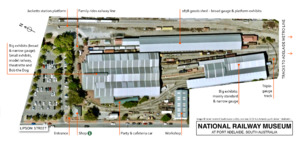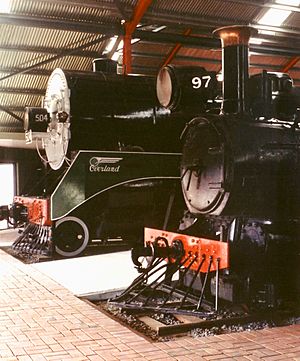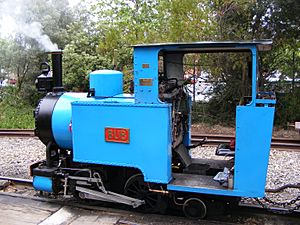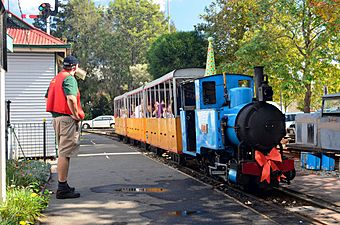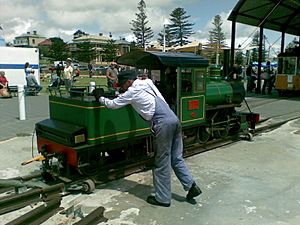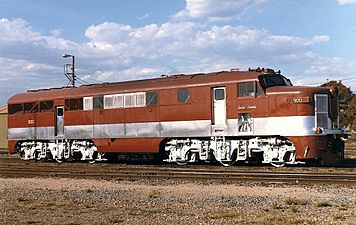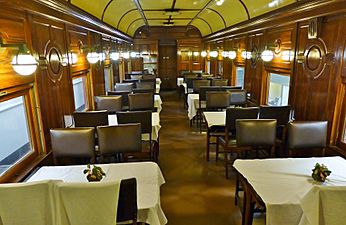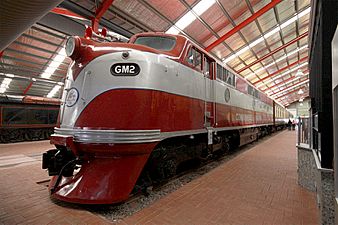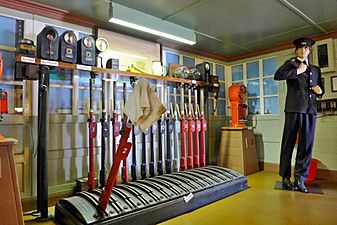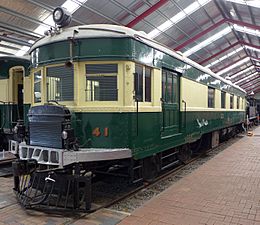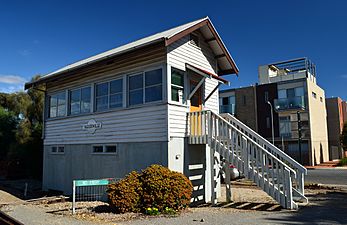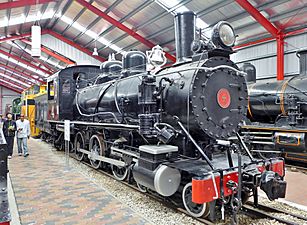National Railway Museum, Port Adelaide facts for kids
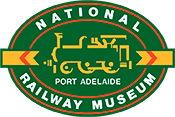 |
|
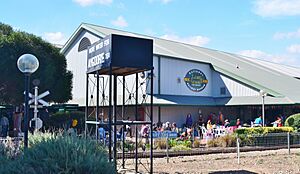
The Ron Fitch Pavilion – one of the two main pavilions – at the museum
|
|
| Established |
|
|---|---|
| Location |
|
| Type | Railway museum |
| Owner | National Railway Museum Inc. |
| Nearest car park | Adjacent |
The National Railway Museum in Port Adelaide, South Australia, is Australia's biggest indoor railway museum. It has over 100 large train exhibits. Most of these trains come from the South Australian Railways (SAR) and Commonwealth Railways, as well as their later company, Australian National. The museum is spread across a big area of about 3.5 hectares (8.6 acres). It also keeps a huge collection of old photos and records from these railway companies. Many dedicated volunteers help run the museum every day.
Contents
History of the Museum
Starting at Mile End (1964–1988)
In 1963, some people who loved trains wanted to save old steam locomotives. They asked the South Australian Railways to give them land near the old Mile End train depot. The first train arrived in 1964.
In 1970, this place opened as the Mile End Railway Museum. Not many trains were covered, so the weather started to damage them. The museum then looked for a new, indoor place to keep its collection safe.
Moving to Port Adelaide
In 1987, the Mile End Railway Museum received a special grant of $2 million. This money was part of Australia's 200th birthday celebrations. They used it to build a new museum at the old Port Dock goods terminal.
The Mile End museum closed in January 1988. Just 11 months later, in December 1988, the new museum opened. It was called the Port Dock Station Railway Museum.
Becoming the National Railway Museum
In 1999, the museum received more funding. This was for Australia's 100th birthday as a nation. They used the money to build a Commonwealth Railway Museum section. This new part opened in 2001.
It shows trains from the Commonwealth Railways and Australian National Railways Commission. These include famous trains like The Ghan, Tea and Sugar, and Trans-Australian. When this new section opened, the museum changed its name. It became the National Railway Museum. This idea came from Tim Fischer, who was a deputy prime minister and loved trains.
In May 2009, the main building was named the Ron Fitch Pavilion. Ron Fitch was a railway commissioner who helped the museum get many of its early trains. At the same time, the Commonwealth Railways Museum was renamed the Ronald E. Fluck Pavilion. Ronald E. Fluck was the person who started the museum.
Changes to the Railway Line
In 2017, the government planned to build a new train station near the museum. This would connect to the main railway line. The project was paused in 2019 because costs went up. Work on it stopped in January 2020.
In June 2023, the project started again. It cost about $51 million. This work meant some of the museum's train tracks were removed. The museum also lost some land it used for storing trains. The new station was designed to be used by both regular suburban trains and special heritage trains.
Museum Collection
The museum has a huge collection of trains and railcars. They are kept in two large buildings and an old goods shed. The museum shows trains that ran on all three main railway track sizes in Australia:
- Narrow gauge (1067 mm or 3 ft 6 in)
- Standard gauge (1435 mm or 4 ft 8.5 in)
- Broad gauge (1600 mm or 5 ft 3 in)
There are over 100 major exhibits. Most are from the Commonwealth Railways and South Australian Railways. The museum also has trains from the Silverton Tramway and Victorian Railways.
Some trains and railcars at the museum can still run. These include:
- Narrow gauge: The steam locomotive Peronne (built in 1918).
- Broad gauge: Diesel locomotives 515 and 801. Also, "Red Hen" railcars 321 and 400, and "Bluebird" railcar 257.
The museum also has smaller locomotives like Bill and Bub. These give visitors rides on a special 457 mm (18 in) track around the museum grounds.
Locomotives and Railcars (as of 2025)
- Steam locomotives
- SAR Rx 93
- SAR Y 97
- SAR P 117
- SAR T 253
- SAR F 255
- SAR 409
- SAR 504 Tom Barr Smith
- SAR 523 Essington Lewis
- SAR 624
- SAR 702
- SAR (ex VR) 752
- CR G 1
- CR NM 34
- Silverton Tramway Y 12
- Silverton Tramway A 21
- Silverton Tramway W 25
- Broken Hill Associated Smelters Peronne
- BHP Whyalla no. 4
- Diesel locomotives
- SAR diesel shunter 515 & 517 (no. 515 is operational)
- SAR mainline diesel 703 (static, to be operational)
- SAR diesel shunter 801 (operational)
- SAR mainline diesel 900
- SAR mainline diesel 930
- CR GM class GM 2
- CR mainline diesel NSU 61
- CR diesel shunter DE 91
- Railcars
- SAR Model 55 Brill railcar 8
- SAR Model 75 Brill railcar 41
- SAR Bluebird railcar 257 Kestrel (operational)
- SAR Redhen railcars 321 and 400 (operational)
- STA 2000 class railcars 2006 and 2112
- CR Budd Railcar CB 1
Museum Operations
The museum uses some of its historic locomotives for special events. Inside the museum, small steam and diesel trains give rides to visitors. These trains run on a 457 mm (18 in) track that is 1.2 km (0.75 mi) long.
In 1992, the museum also built a 1.7 km (1.1 mi) railway line. This line runs along the beach from Semaphore to Fort Glanville. From October to April, trains run on weekends, public holidays, and school holidays. The trains travel along the coast and through sand dunes.
Since 1982, the museum has published a magazine called Catch Point Magazine. It comes out every two months. The magazine has news and articles about railway operations, mostly in South Australia.
Historic Buildings at the Museum
The museum has several old buildings. Some were already on the site, and others were moved there for display.
- Port Dock station goods shed: This is the only original building left from the Port Adelaide station. It was built in 1878. It shows how important Port Adelaide was for trade back then. This building is listed on the SA Heritage Register.
- Woodville signal cabin: This two-story wooden building came from Woodville. It is connected to the narrow-gauge train yard.
- Callington shelter shed: This small building was a typical shelter at country train stations. It was built in 1951 for the small town of Callington.
- Eudunda gangers' shed: This type of shed was used by railway workers called "gangers." They stored their tools and small inspection trolleys here. This shed came from Eudunda.
Gallery
-
Commonwealth Railways dining car DA 52, which served food on trains across the Nullarbor Plain
See also
- List of railway museums


